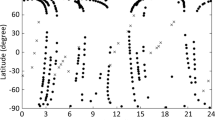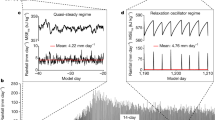Abstract
THE recent Voyager encounter established certain facts about Triton's atmosphere: the surface pressure is in the range 1.5–1.9 Pa (15–19 μbar)1; the surface temperature is 38±3K (ref. 2); molecular nitrogen is the dominant atmospheric constituent3; hazes and clouds are visible not only on the limb but also against the surface4; the wind in the southern hemisphere is to the northeast at low altitudes (as shown by streaks on the surface4) and to the west at high altitudes (as shown by geyser-like plume tails4). Triton rotates with a period of 5.877 days in a right-hand sense about the south pole, where the season now is late spring4. Here we argue that these features can be explained if Triton, like Mars5, has a global, well-structured atmosphere in equilibrium with surface frosts. The subliming frost cap produces a polar anticyclone at low altitudes, with northeastward winds of ∼5 m s−1 within the Ekman boundary layer. The temperature contrast between the cold frost-covered pole and the warm unfrosted equator produces westward winds at high altitudes.
This is a preview of subscription content, access via your institution
Access options
Subscribe to this journal
Receive 51 print issues and online access
$199.00 per year
only $3.90 per issue
Buy this article
- Purchase on Springer Link
- Instant access to full article PDF
Prices may be subject to local taxes which are calculated during checkout
Similar content being viewed by others
References
Tyler, L. et al. Science 246, 1466–1473 (1989).
Conrath, B. et al. Science 246, 1454–1459 (1989).
Broadfoot, L. et al. Science 246, 1459–1466 (1989).
Smith, B. A. et al. Science 246, 1422–1449 (1989).
Leighton, R. B. & Murray, B. C. Science 153, 136–144 (1966).
Trafton, L. Icarus 58, 312–324 (1984).
Trafton, L. & Stern, S. A. Astrophys. J. 267, 872–881 (1983).
Ingersoll, A. P., Summers, M. E. & Schlipf, S. G. Icarus 64, 375–390 (1985).
Ingersoll, A. P. Icarus 81, 298–313 (1989).
Lane, A. L. et al. Science 246, 1450–1454 (1989).
Brown, G. N. Jr & Ziegler, W. T. Adv. Cryogen. Engng 25, 662–670 (1980).
Holton, J. R. An Introduction to Dynamic Meteorology 2nd Edn (Academic, New York, 1979).
Houghton, J. T. The Physics of Atmospheres 2nd Edn (Cambridge University Press, 1986).
Priestley, C. H. B. Turbulent Transfer in the Lower Atmosphere (University of Chicago Press, 1959).
French, R. G. & Gierasch, P. J. J. geophys. Res. 84, 4634–4642 (1979).
Haberle, R. M., Leovy, C. B. & Pollack, J. B. Icarus 39, 151–183 (1979).
Cruikshank, D. P., Brown, R. H. & Clark, R. N. Icarus 58, 293–305 (1984).
Cruikshank, D. P., Brown, R. H., Giver, L. P. & Tokunaga, A. T. Science 245, 283–286 (1989).
Author information
Authors and Affiliations
Rights and permissions
About this article
Cite this article
Ingersoll, A. Dynamics of Triton's atmosphere. Nature 344, 315–317 (1990). https://doi.org/10.1038/344315a0
Received:
Accepted:
Issue Date:
DOI: https://doi.org/10.1038/344315a0
This article is cited by
-
Sublimation as an effective mechanism for flattened lobes of (486958) Arrokoth
Nature Astronomy (2020)
-
Global warming on Triton
Nature (1998)
-
Triton's streaks as windblown dust
Nature (1990)
Comments
By submitting a comment you agree to abide by our Terms and Community Guidelines. If you find something abusive or that does not comply with our terms or guidelines please flag it as inappropriate.



